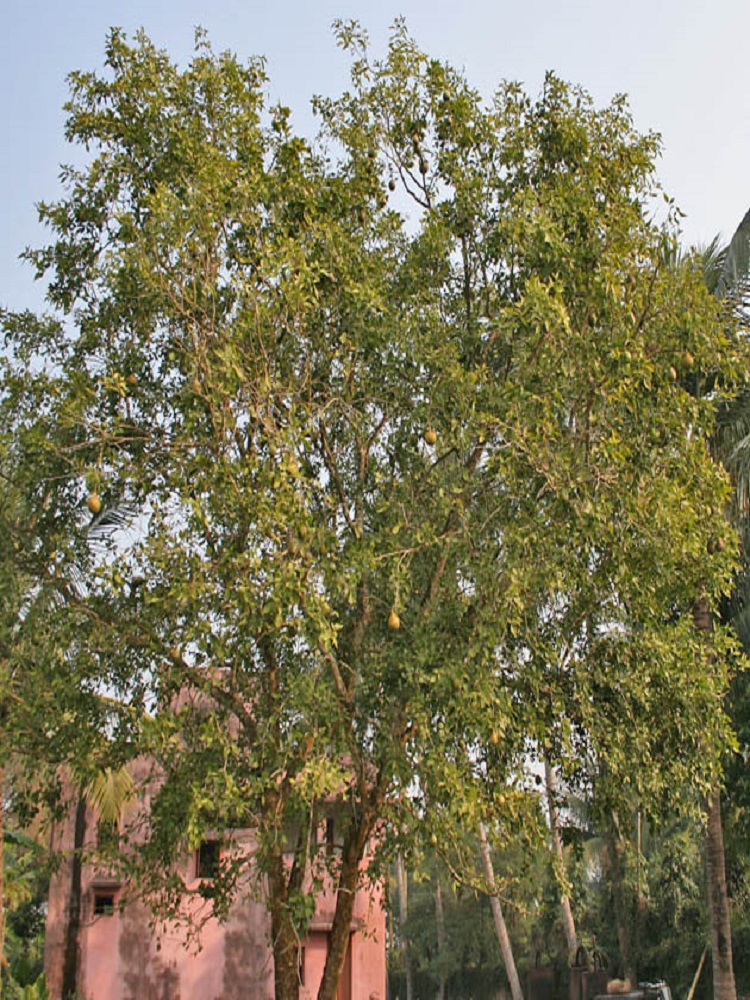Bael - Wood Apple Tree

Aegle marmelos
Summary
Scientific Classification
Kingdom: Plantae
Division: Magnoliophyta
Class: Dicotyledonae
Order: Sapindales
Family: Rutaceae
Genus: Aegle
Species: A.marmelos
Scientific Name: Aegle marmelos (L.) Correa.
Common Names:
English: Bel, Beli fruit, Bengal quince, Stone apple, Wood apple.
Hindi: Bael.
Kannada: Bilvapatre.
Marathi: Bel, Maredu.
Description:
- Habit and Habitat: A thorny deciduous tree, with greyish - white or greyish - brown, smooth bark. Woody, erect, cylindrical and branched. Grows up to 15 meters tall and bears thorns and fragrant flowers.
- Distribution: Bel is a fruit-bearing tree which is cultivated throughout India, as well as in Sri Lanka, northern Malaya, Java and Philippines. The tree, which is the only species in the genus.
- Morphology:
Leaf: Leaves are alternate, pale green, trifoliate; terminal leaflet, 5.7 cm long, 2.8 cm broad, having a long petiole; the two lateral leaflets, almost sessile, 4.1 cm long, 2.2 cm wide, ovate to lanceolate having reticulate pinnate venation; petiole, 3.2 cm long. Exstipulate, petiolate, compound, trifoliate, leaflets ovate - elliptic or elliptic - lanceolate, glabrous.
Inflorescence: Axillary panicles.
Flower: Bracteate, complete, actinomorphic, hypogynous, pentamerous, Flowers greenish or creamy white. Calyx 5, gamosepalous. Corolla 5, polypetalous, imbricate. Flowers, greenish white, sweetly scented, bisexual, stalked; stalk, 8 mm long; diameter of a fully open flower is 3 cm; flowers, borne in lateral panicles of about 10 flowers, arising from the leaf axils.
Androecium: Androecium with many stamens, polyandrous, dithecous, introrse.
Gynoecium: Gynoecium pentacarpellary, syncarpous, superior, multilocular, axile placentation.
Fruit: skin of some forms of the fruit is so hard it must be cracked open with a hammer. Berries 6 - 10 cm across, globose or sub-globose, with rough rind; rind greenish-white, on ripening yellow. Seeds: obliquely lenticular or oblong, wrinkled, pale - brown, glabrous.
Flowering and Fruiting: March-June. - Propagation: Through seeds.
- Importance:
The juice is strained and sweetened to make a drink similar to lemonade, and is also used in making Sharbat. It is a sacred tree, dedicated to Lord Shiva. The offering of bael leaves is a compulsory ritual of the worship of Lord Shiva in the hills. This importance seems largely due to its medicinal properties. All parts of this tree, viz., root, leaf, trunk, fruit and seed, are used for curing one human ailment or another. The bark of the tree yields a yellow dye, which was used for dyeing wool and linen. The tree provides good timber and the wood is used in furniture, buildings, agricultural implements, turnery, bobbins etc. It is also very good timber for flooring and paneling. The bark is used as an antiseptic. The roots are used as astringent in dysentery. The tree has a religious significance in Hindu marriage rituals. It is excellent for bobbins and suitable for battery separators. - Location: Botanical Garden.
 Trees of GSS Project supported by Makerspace Belgaum Website concept and designe by
Trees of GSS Project supported by Makerspace Belgaum Website concept and designe by